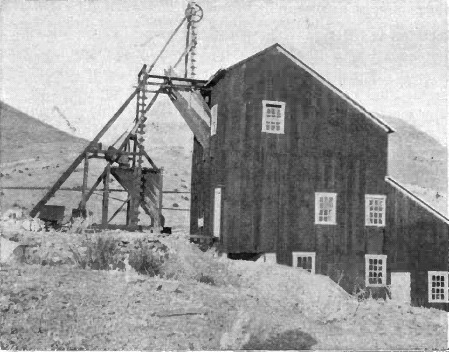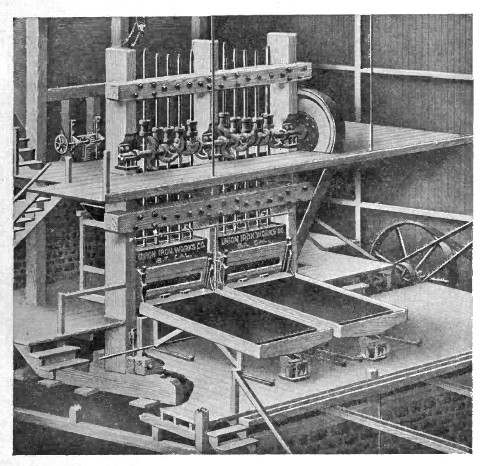To work a furnace such as this, it should be fired slowly for a day before roasting begins. The pyrites, preferably dry and free from lumps, should be fed in at the top until about four inches deep. The temperature should be barely sufficient to distil the sulfur off. As they are moved down by rabbling, the sulfur given off will commence to burn, and while this action is going on rabbling should be carried on vigorously. The ore is shifted to the next rabbling door, a fresh lot being run on to the first hearth. After all energetic action is over, it will be found that almost the whole of the material is magnetic, partly magnetic sulfide, but mainly magnetic oxide; this material may be brought down, a door at a time, a fresh charge going in as soon as the top one is moved down. Fuel should only be put on when the" material has been discharged from the last hearth. As soon as the smoky flame has ceased the sand may be brought on to the last hearth, and each lot brought down one door, the greatest time being spent near the top in simply stirring the almost raw pyrites. The sparking towards the lower doors when the ore is turned over or allowed to run from the spadelle through hot air will indicate the progress of roasting, but a simple horseshoe magnet, as recommended by me many years ago, and now extensively used, supplies the best guide to the rate of the roast.
The temperature should always be high enough to decompose any sulfate of iron, but in most cases only traces of this are to be found at any part of the furnace. Sulfate of zinc and sulfate of copper form readily, but they have practically no deleterious effect on chlorine solutions, and may be disregarded. If the ore has been roasted at a low temperature, to start with and a full red, but not high enough to melt gold, at the finish, and if a few odd specks only adhere to a magnet when tested on a sample of the cooled sand, the ore is roasted. Very often salt is used, in most cases uselessly, for just as good an extraction may be got without using it at an. There is also danger of some volatilization of gold, but in most cases statements made on this score are exaggerated. Probably when lead or copper is present these may be chloridized to a certain extent by the salt crudely fed in. The salt should only be added at the lowest door a few minutes prior to discharging. After roasting, gold ore may be treated either by chlorine or cyanide. If there are no compounds capable of destroying cyanide or unduly using it up, then it should be used in preference to chlorine. Gold will be dissolved almost as speedily by dilute solutions of cyanide as by chlorine solutions of equivalent strength. If much lime or magnesia, oxide of zinc, or even finely divided clayey material of slimes be present, an inordinate amount of chlorine would be used up. In this case either a cheap acid wash, such as with sulfuric, should be given to neutralize these compounds, and then the chlorine solutions or gas may be applied. However, it is simpler to run on cyanide solutions. As to which is the best way of applying chlorine, it may be stated that if the gas is applied as recommended by Platther, that is, passed through the slightly moistened ore, then if the gas passes perfectly through the ore, the gold will be dissolved in 48 hours. The time generally recommended 24 hours is too snort, and if all the gold does not dissolve in 48 hours, then it is of no use applying chlorine for a longer time. If pressure is used by forcing in an extra amount of gas then a more speedy solution may be obtained, but at the expense of more chlorine. After seeing various forms of barrels at work, including Mears, Newberry-Vauun, and Rothwell's, the author can positively say that no more gold is dissolved by these processes that can be extracted by the Platther system. By only slightly damping the sand a saturated solution of chlorine is always kept in contact with the gold. The closed vat system is, on the other hand, troublesome. Gaseous chlorine has to generated and kept going. Solutions are highly charged with the gas, and give it off freely; a leak in a generator, pipe or vessel is always a great source of trouble.
It is also difficult to reduce the work to routine. The open vat system or modified Munktells, is more easily managed, while much larger quantities of ore may be handled. In this, chloride of lime and sulfuric acid are mixed, so as to liberate about 4oz. of chlorine to the cubic foot of solution. The sulfate of lime should be allowed to settle. The plan of running the two so as to mix the two in the stem of a Y pipe, under the belief that chlorine under those conditions is nascent, is absurd. These solutions may take as much as from 10 days to a fortnight to dissolve the gold; in some cases it comes away in from three to four days; further, the top of the ore will often lose nearly all its gold when the bottom is untouched, and finally if such solutions are run through for any length of time channels tend to form, giving unequal extractions. Sulfate of lime also tends to clog up the filter-bed, which should be carefully looked to from time to time. Chlorinated water, as used at Mount Morgan, is preferable to the mixture used in the Munktell process, but it would not pay a small company to erect a plant on the same lines. In the case of the open vat system, a large amount of chlorine invariably escapes; the light destroys a great deal more, and usually a great deal in excess is run through the ore and wasted when the gold is precipitated.
The Black permanganate process has the advantage of being a clean process, absolutely free from escaping chlorine, and show's at once by the fine red color of the solutions when the ore has ceased to destroy it. There may be a claim in this case to nascent action, for the permanganic acid, as long as it is present, shows a gorgeous color; chlorine is liberated from the salt, but as soon as used up in dissolving gold a fresh portion appears to be liberated, in other words, chlorine is not instantly set free from the materials present, but in the same way as from aqua regia. From experiments on a considerable scale, I can say that if it is applied properly, just as much gold will be dissolved in the same time as with any chlorine solution process. It has the advantage also of being much cheaper than any. If an ore contains copper chalcopyrite, gold, and silver, it may be roasted, then created with dilute sulfuric acid, or by the permanganate process. The gold and almost the whole of the copper may be dissolved; the gold can be precipitated either on charcoal, with sulfur dioxide, or by fractional precipitation with sulfuretted hydrogen, and the copper precipitated on scrap iron.
All acids should then be washed out, an alkaline solution run on, and the silver and a small quantity of the remaining gold extracted by cyanide solutions. This method was adopted successfully years ago at our school works on ten ton parcels. With other metals present other methods would be adopted; but it cannot be said that many gold ores are absolutely refractory. Pyrite, arsenopyrite, and sphalerite, give no trouble worth mentioning ; pyrrhotite or magnetic pyrites, copper ores, and galena are more , difficult to roast, the last especially causing trouble in some instances. Antimony in small quantities, either by itself as sulfide, or with other metals, such as copper and lead, in tetrahedrite ore and bournonite, the last a rather common mineral accompanying gold, and often mistaken for galena, does not make an ore impossible to treat; but if the percentage of stibnite or such minerals is high ordinary methods fail. By mixing a small amount of stibnite with a large amount of pyrites, the gold from both may be extracted; but a simple method for recovering both antimony and gold remains to be discovered. Probably some of the electrolytic methods patented will be yet simplified sufficiently for ordinary practice. In concluding these somewhat scrappy articles, attention should be drawn to tailings assays. The young metallurgist who s arts so often hears that the gold from various classes of ore has been extracted down to a pennyweight, or even n few grains, or o ten only a trace. He finds that he cannot do such close work, and knows that he dare not confess it; in consequence of this, he is placed very often in a false position. In travelling round the goldfields of Australia I had excellent opportunities of taking samples of tailings from all places, and although not one assay of these has been disclosed, it may be positively stated that the only cases in which traces of gold were left in were those ores which originally carried very few pennyweights per ton. Next it may be said that many believed their tailings to be barren, and did not hesitate to say so; yet they were never tested by any proper assay; others who assayed deluded themselves by taking such small quantities that their balances faithfully recorded a trace, whereas if reasonable quantities had been taken pennyweights per ton should have been put down. In fact, with regard to this matter, a clean sweep of most statements can be made. Up to 90 percent of the gold may be extracted by amalgamation processes from suitable oxidized ores. Concentrates, whether 100z. to the ton or 5oz. to the ton, should be brought down to less than 4dwt. per ton by chlorination ; but it "will be found almost impossible to bring them to less than from 2 to 3 dwt. Per ton. They may be reduced to the same values with cyanide solutions. If they are finely ground or are slimes, they may come down to slightly below one pennyweight per ton, but this is one of the rare extractions. Any tailings left with 5 pennyweights to the ton or more may be looked upon as the residues of bad metallurgical work. Of course from the best mills bad batches will occasionally be turned out, but there is something radically wrong when high tails are turned out repeatedly without the slightest effort to check the waste and modify the process for better recovery.
Continue on to:
Stamp Mills
Return To:
Hard Rock Quartz Mining and Milling


